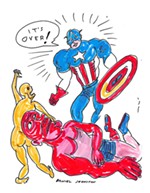Prince of Prints
By Robert Faires, Fri., April 4, 2003
Steinberg's pioneering understanding of the importance of prints is a good example of why his career is as distinguished as the collection of prints he assembled. His scholarship and criticism in art of both Renaissance Europe and 20th-century America has broken new ground in those fields. In his published works of the 1960s, such as Encounters With Rauschenberg and Jasper Johns, he opened our eyes to new artists worth seeing, and in writings such as The Sexuality of Christ in Renaissance Art and in Modern Oblivion, Leonardo's Incessant Last Supper, and Michelangelo's Last Paintings, he opened our eyes anew to works we only thought we had seen before. Steinberg has lectured at museums and universities across the country, including the Metropolitan Museum of Art, the Guggenheim Museum, Yale, Stanford, Berkeley, and Columbia University. He delivered the Gauss Lectures at Princeton, the Norton Lectures at Harvard, and the Mellon Lectures at the National Gallery of Art. Steinberg taught art history first at Hunter College, then at the Graduate Center of the City University of New York, where he co-founded the art history department, and finally at the University of Pennsylvania, where he worked for 16 years. Since retiring from teaching in 1991, he has made his home in New York City.








